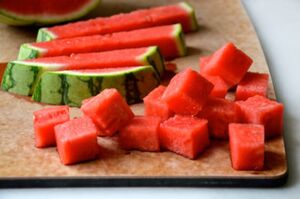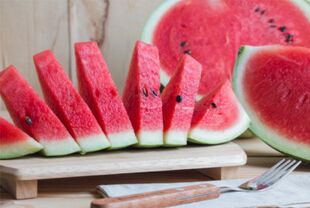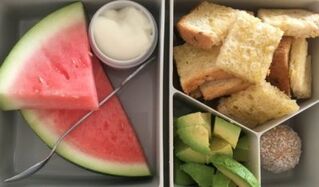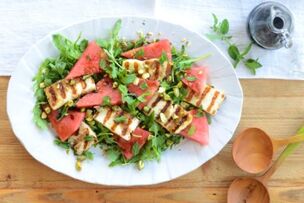Probably not many people dislike the sweet berry type. More than 90% of it consists of juice, its benefits are indicated for urolithiasis, since there is practically no acid or salt in the juice, but a large amount of alkaline. In the composition of watermelon also has a fairly large amount of magnesium, just eating a piece of watermelon is enough to get the ratio of phosphorus, iron, potassium, calcium daily.
It contains easily digestible sugars, trace elements, vitamins B, C, PP. These berries will help cure diseases of the cardiovascular system, high blood pressure, and high cholesterol. If you have been taking antibiotics for a long time, the juicy pulp will help remove the residue from the body.

But the most important thing that we want to talk about is that watermelon is a great aid in weight loss, since there are only 30-40 kcal per hundred grams of pulp, but at the same time it bringssatiety, and the presence of folic acid helps to improve fat metabolism, helps with the work of the circulatory and immune systems.
The success in weight loss is achieved due to the diuretic effect of this berry, and the positive elimination of toxins, poisons and other toxic substances in the body. The diuretic properties of watermelon are milder than those of drugs. A very important element in the composition of watermelon pulp is the carotenoid lycopene, which has anti-tumor properties, helping to slow down aging, slim down and filter the blood.
Test for nitrate in watermelon. Contraindications
Of course, it is only possible to do the watermelon diet in late summer, when the watermelon is ripe without the addition of accelerators and chemicals. Today, watermelon can be purchased in the store at any time of the year, but we do not recommend it. In general, it is best to get the fruits grown in your garden (if you are a resident of the southern regions of the country), they may not be sweet, colorful but you will be completely assured of their quality. amount of them.
You can check the amount of nitrate in watermelon in the following way: put a piece of pulp in a glass of water, if it contains nitrates, the pulp will be soft in the glass, turning to a paste, without nitrates then the real piecehealth will keep the shape. Eating watermelons during their ripening period will get both benefits and enjoyment, because the juice of this fruit will perfectly quench your thirst, and cleanses the body not only. by urinating but also by sweating, cleansing the skin, tightening pores, and replenishing the body with trace elements.

The watermelon diet is easy to tolerate. During the diet phase you will only have to eat this berry, but at the same time in large quantities and at any time, possibly at night (as long as you take into account that you will often have to get up to the bathroom)and you won't feel hungry. At the same time, you do not need a headache to calculate the amount of calories consumed to know that one kilogram of pulp is equivalent to ten kilograms of your body weight.
Should divide watermelon consumption into 5 - 6 times, every 3 hours. This technique is ideal for the benefit of the body. Following the watermelon diet, you will get results pretty quickly. If you still find it difficult to just eat watermelon, you can add a small amount of rye, bran bread to your diet. But in this case, the diet will have to be lengthened.
Contraindications to the watermelon diet related to people with impaired renal function and genitourinary system (pyelonephritis, kidney stones) and diabetes mellitus.
Watermelon diet - menus and results
When following the watermelon diet, you can lose 3-5 kg in a week and in 14 days, you can lose up to 7-8 kg. But you need to prepare for such a complex and long-term diet, enter it gradually, and only if you are confident in your health!
The 14-day diet allows you to include small amounts of different foods in your diet, but keep in mind that they don't contain too many calories.
For breakfast, you can add one boiled egg or 100 grams of low-fat cheese or a small amount of porridge in water. For lunch, eat a slice of lean beef or veal, or a slice of chicken or fish, all of these should be boiled or steamed, vegetables. Dinner should only have watermelon pulp.
Can be combined with watermelon diet with other foods. We offer several diet options with different menus:
Watermelon diet
The first option:
Breakfast- - toast, low-fat cheese 60-80 gr. , 200 gr of melons; Lunch
- - up to 150 grams of boiled fish, lettuce and melon, 150 grams of cheese;
- afternoon tea - 400-500 grams of watermelon pulp; Dinner
- - one boiled rice (150-200 grams), carrot + apple 100 grams, a piece of melon.
Second option:
Breakfast- - a boiled egg, 150-200 grams of watermelon pulp;
- lunch - stewed vegetables 100-150 grams, melons 350-400 grams;
- afternoon snack - low-fat cheese 150-200 grams; Dinner
- - 100-150 grams of boiled chicken or turkey, toast and 400-500 grams of watermelon pulp.
Third option:
- breakfast - natural yogurt 150 grams, watermelon 400-500 grams of watermelon diet watermelon;
- lunch - steamed turkey or chicken fillet 100-150 grams, rice 150 grams, melon 400-450 grams;
- afternoon snack - a piece of bran bread or crispy bread;
- dinner - vegetable salad 150-200 grams, one boiled potato, 400-500 grams of watermelon, diet watermelon.
Fourth option:
Breakfast- - toast with rye + cheese, 200-300 grams of watermelon or oatmeal with melon; Lunch
- - boiled chicken breast with buckwheat porridge and fresh vegetable salad, or vegetable soup without potatoes and 100-150 grams of boiled (or steamed) lean meat, or 100 grams steamed turkey cutlets, 100 grams of riceand green beans;
- Afternoon snack 300-400 grams of watermelon; Dinner
- - 100-120 grams of low-fat cheese and 200-300 grams of melon.
If you are on a melon diet, do not drink it immediately after a meal. You can drink green tea or a glass of water for an hour. The menu must be alternate.

Watermelon-kefir diet, protein and bread
- The watermelon-kefir diet consists of two products, kefir containing 0 or 1 percent fat and watermelon. Need to eat one cup of kefir or 300-400 grams of watermelon pulp every three hours. It is better to start the day with watermelon pulp and end with kefir.
- Watermelon-protein diet implies consuming watermelon between meals - 400-500 grams for 10-14 days. The main food products these days should be: boiled chicken or turkey fillets, fat-free steamed fish, eggs, low-fat cheese and cheese and low-fat kefir, seafood, vegetables.
- A diet with watermelon and black bread implies consuming 0. 5 loaves of black bread (the better one) and watermelon pulp per day, as mentioned above - at a rate of one kilogram of pulpper 10 kg of body weight. If you want and if you can, reduce your bread intake to 100 grams or replace it with two tablespoons. tablespoon of oat bran and you can add it to a salad of thinly sliced white cabbage, carrots and beets, a few drops of lemon juice and olive oil.
If at the end of the diet you get rid of it correctly (the main rule is slowly), the lost kilograms will not return to you, in any case, not as fast as you. have reduced them. To do this, follow these rules for two weeks after your watermelon diet: 1) don't skip breakfast, 2) your diet should include foods rich in protein and carbohydrates, 3) It is important not to slow down your metabolism.
The main staple after the two-week diet should be:
porridge- ;
- boiled or steamed lean fish;
- boiled lean meat (chicken, turkey);
- fermented dairy products (low-fat cheese and kefir, natural yogurt);
- vegetables;
- fruit;
- eggs.

And 2-3 hours before going to bed, continue to eat a kilogram of watermelon for 30 kg of body weight.
Watermelon fasting days can be arranged 2-3 times a week, eating two kilograms of watermelon pulp. It's very important: get physically active to the best of your ability, at least at home, without a trainer and gym, or in the form of walking.












































